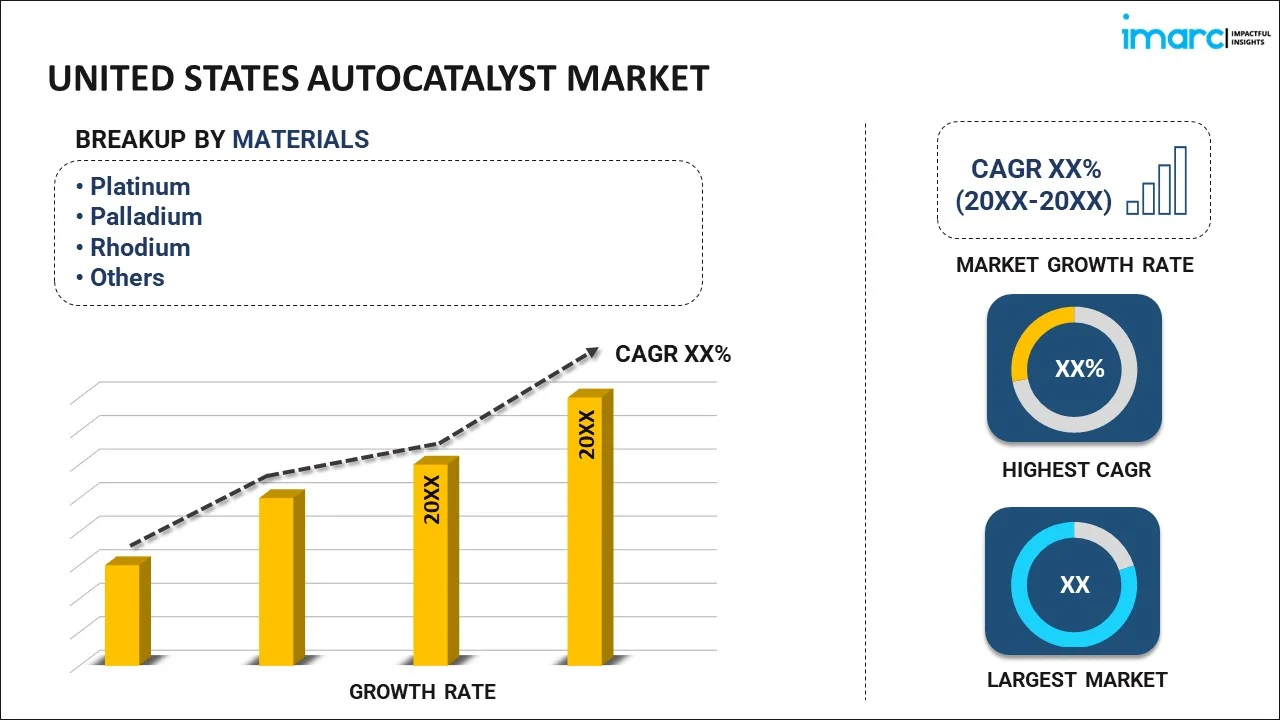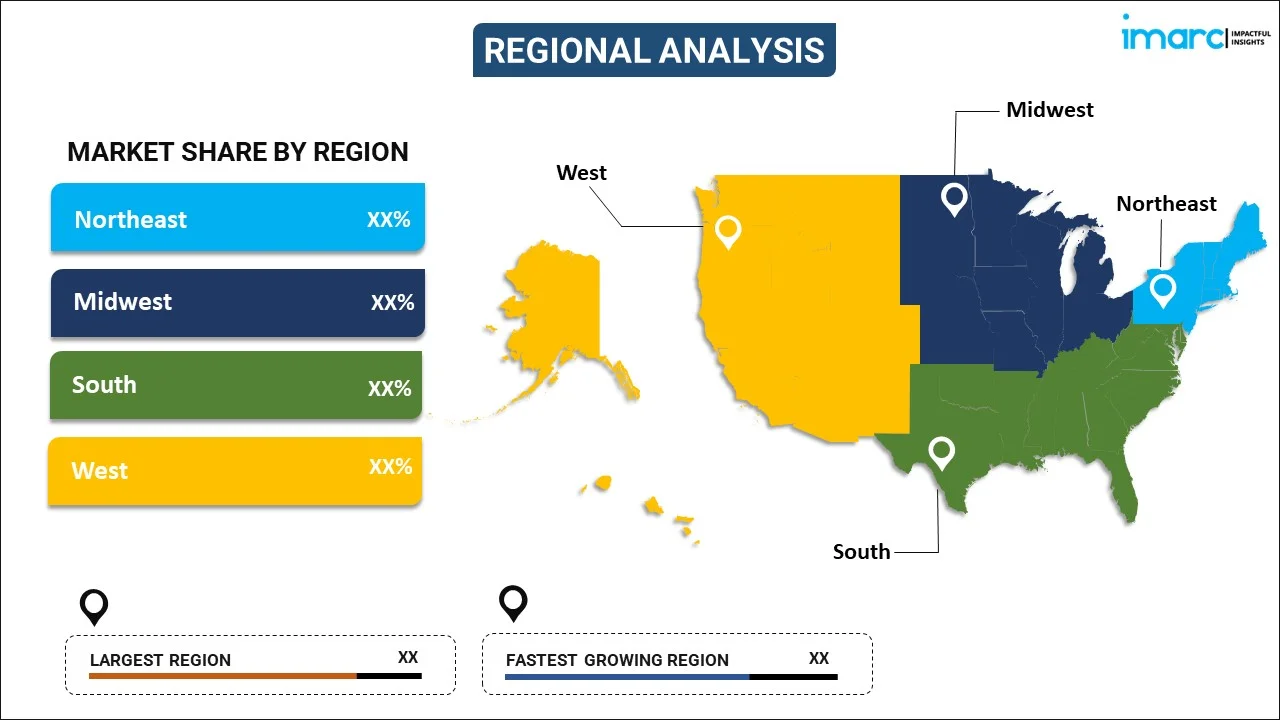
United States Autocatalyst Market Report by Material (Platinum, Palladium, Rhodium, and Others), Catalyst Type (Two-Way, Three-Way, Four-Way), Distribution Channel (OEM, Aftermarket), Vehicle Type (Passenger Car, Light Commercial Vehicle, Heavy Commercial Vehicle, and Others), Fuel Type (Gasoline, Diesel, Hybrid Fuels, Hydrogen Fuel Cell), and Region 2025-2033
Market Overview:
The United States autocatalyst market size reached USD 3.4 Billion in 2024. Looking forward, IMARC Group expects the market to reach USD 4.5 Billion by 2033, exhibiting a growth rate (CAGR) of 3.3% during 2025-2033. The implementation of environmental regulations and standards aimed at reducing harmful emissions, the growing automotive industry, and the growing consumer awareness about the environmental benefits of using autocatalysts are some of the key factors driving the market.
|
Report Attribute
|
Key Statistics
|
|---|---|
|
Base Year
|
2024 |
|
Forecast Years
|
2025-2033
|
|
Historical Years
|
2019-2024
|
| Market Size in 2024 | USD 3.4 Billion |
| Market Forecast in 2033 | USD 4.5 Billion |
| Market Growth Rate (2025-2033) | 3.3% |
An autocatalyst is a critical component used in the exhaust system of vehicles. It serves to reduce harmful emissions by converting them into less harmful substances through a catalytic process. Specifically, the autocatalyst contains a core coated with a catalyst, often composed of precious metals, including platinum, palladium, and rhodium. When exhaust gases pass over this catalyst, harmful pollutants such as carbon monoxide, nitrogen oxides, and unburned hydrocarbons undergo a chemical transformation into more environmentally benign substances, such as carbon dioxide, nitrogen, and water vapor. The application of autocatalysts has become an essential practice in automotive manufacturing to meet stringent environmental regulations and improve air quality. In addition to supporting ecological sustainability, the advancement in autocatalyst technology also drives the demand for precious metals, influencing global economic dynamics. Therefore, the autocatalyst is not just a critical part of modern vehicles, but also an essential tool in our ongoing efforts to minimize environmental impact.
United States Autocatalyst Market Trends:
The United States autocatalyst market is experiencing significant growth, driven by environmental regulations and standards aimed at reducing harmful emissions. The U.S. government’s push for greener transportation and stricter emissions regulations is compelling automotive manufacturers to implement autocatalyst systems in vehicles. This is helping in controlling exhaust emissions that contain pollutants such as carbon monoxide, hydrocarbons, and nitrogen oxides. Moreover, the growing automotive industry in the region and the rising demand for fuel-efficient vehicles equipped with advanced emission control technologies are propelling the market growth. Along with this, the trend of adopting hybrid and electric vehicles is also supporting the demand for autocatalysts, as they play a key role in minimizing emissions. In addition, the continual technological advancements in autocatalyst materials and manufacturing processes, the shift towards downsized engines, and the growing consumer awareness about the environmental benefits of using autocatalysts have collectively contributed to the expansion of the market across the country. Additionally, the market is also witnessing a rise in demand for palladium and platinum, which are crucial components of autocatalysts. Besides these factors, the move towards eco-friendly solutions and the increasing R&D investments by major automotive players in the United States are shaping the market trends. Furthermore, the emergence of innovative autocatalyst products that align with the evolving automotive technologies and the push for sustainable manufacturing practices are creating a positive market outlook. Some of the other factors driving the market include extensive research and development (R&D) activities conducted by key players, continuous product innovations, and consumer-driven factors.
United States Autocatalyst Market Segmentation:
IMARC Group provides an analysis of the key trends in each segment of the United States autocatalyst market report, along with forecasts at the country level for 2025-2033. Our report has categorized the market based on material, catalyst type, distribution channel, vehicle type, and fuel type.
Material Insights:

- Platinum
- Palladium
- Rhodium
- Others
The report has provided a detailed breakup and analysis of the market based on the material. This includes platinum, palladium, rhodium, and others.
Catalyst Type Insights:
- Two-Way
- Three-Way
- Four-Way
A detailed breakup and analysis of the market based on the catalyst type have also been provided in the report. This includes two-way, three-way, and four-way.
Distribution Channel Insights:
- OEM
- Aftermarket
The report has provided a detailed breakup and analysis of the market based on the distribution channel. This includes OEM and aftermarket.
Vehicle Type Insights:
- Passenger Car
- Light Commercial Vehicle
- Heavy Commercial Vehicle
- Others
A detailed breakup and analysis of the market based on the vehicle type have also been provided in the report. This includes passenger car, light commercial vehicle, heavy commercial vehicle, and others.
Fuel Type Insights:
- Gasoline
- Diesel
- Hybrid Fuels
- Hydrogen Fuel Cell
The report has provided a detailed breakup and analysis of the market based on the fuel type. This includes gasoline, diesel, hybrid fuels, and hydrogen fuel cell.
Regional Insights:

- Northeast
- Midwest
- South
- West
The report has also provided a comprehensive analysis of all the major regional markets, which include Northeast, Midwest, South, and West.
Competitive Landscape:
The report has also provided a comprehensive analysis of the competitive landscape in the market. Competitive analysis such as market structure, key player positioning, top winning strategies, competitive dashboard, and company evaluation quadrant has been covered in the report. Also, detailed profiles of all major companies have been provided.
United States Autocatalyst Market Report Coverage:
| Report Features | Details |
|---|---|
| Base Year of the Analysis | 2024 |
| Historical Period | 2019-2024 |
| Forecast Period | 2025-2033 |
| Units | Billion USD |
| Scope of the Report | Exploration of Historical and Forecast Trends, Industry Catalysts and Challenges, Segment-Wise Historical and Predictive Market Assessment:
|
| Materials Covered | Platinum, Palladium, Rhodium, Others |
| Catalyst Types Covered | Two-Way, Three-Way, Four-Way |
| Distribution Channels Covered | OEM, Aftermarket |
| Vehicle Types Covered | Passenger Car, Light Commercial Vehicle, Heavy Commercial Vehicle, Others |
| Fuel Types Covered | Gasoline, Diesel, Hybrid Fuels, Hydrogen Fuel Cell |
| Regions Covered | Northeast, Midwest, South, and West |
| Customization Scope | 10% Free Customization |
| Post-Sale Analyst Support | 10-12 Weeks |
| Delivery Format | PDF and Excel through Email (We can also provide the editable version of the report in PPT/Word format on special request) |
Key Questions Answered in This Report:
- How has the United States autocatalyst market performed so far and how will it perform in the coming years?
- What has been the impact of COVID-19 on the United States autocatalyst market?
- What is the breakup of the United States autocatalyst market on the basis of material?
- What is the breakup of the United States autocatalyst market on the basis of catalyst type?
- What is the breakup of the United States autocatalyst market on the basis of distribution channel?
- What is the breakup of the United States autocatalyst market on the basis of vehicle type?
- What is the breakup of the United States autocatalyst market on the basis of fuel type?
- What are the various stages in the value chain of the United States autocatalyst market?
- What are the key driving factors and challenges in the United States autocatalyst market?
- What is the structure of the United States autocatalyst market and who are the key players?
- What is the degree of competition in the United States autocatalyst market?
Key Benefits for Stakeholders:
- IMARC’s report offers a comprehensive quantitative analysis of various market segments, historical and current market trends, market forecasts, and dynamics of the United States autocatalyst market from 2019-2033.
- The research study provides the latest information on the market drivers, challenges, and opportunities in the United States autocatalyst market.
- Porter's five forces analysis assist stakeholders in assessing the impact of new entrants, competitive rivalry, supplier power, buyer power, and the threat of substitution. It helps stakeholders to analyze the level of competition within the United States autocatalyst industry and its attractiveness.
- Competitive landscape allows stakeholders to understand their competitive environment and provides an insight into the current positions of key players in the market.
Need more help?
- Speak to our experienced analysts for insights on the current market scenarios.
- Include additional segments and countries to customize the report as per your requirement.
- Gain an unparalleled competitive advantage in your domain by understanding how to utilize the report and positively impacting your operations and revenue.
- For further assistance, please connect with our analysts.
 Inquire Before Buying
Inquire Before Buying
 Speak to an Analyst
Speak to an Analyst
 Request Brochure
Request Brochure
 Request Customization
Request Customization




.webp)




.webp)












